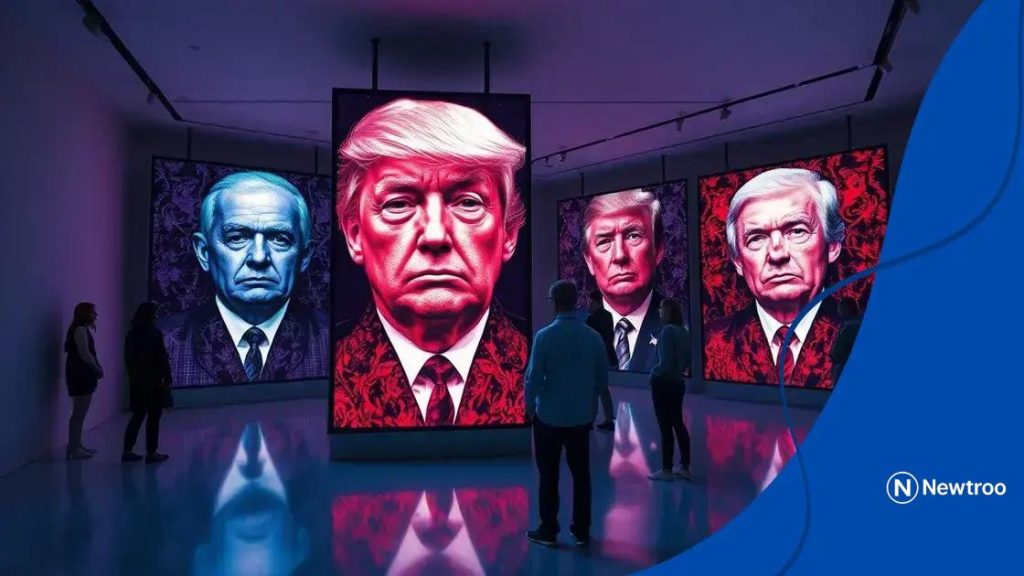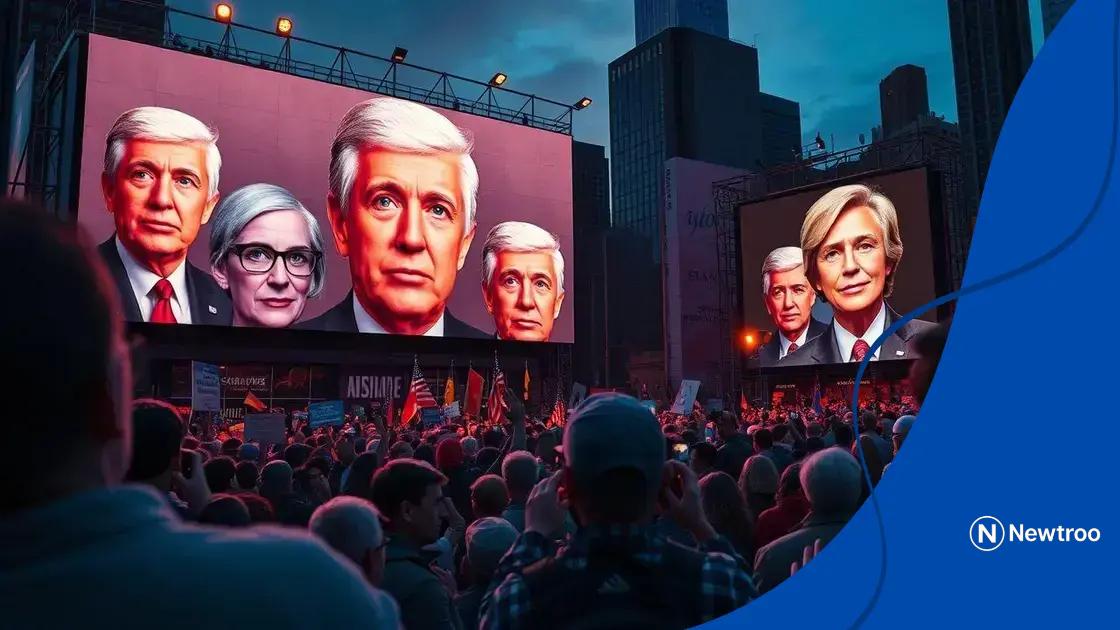Trump criticized over AI-generated Pope image

Anúncios
Trump criticized over AI-generated Pope image highlights the implications of artificial intelligence on public perception, where misinformation can easily spread through social media, challenging trust in media authenticity.
In an unexpected turn, Trump criticized over AI-generated Pope image highlights the blurred lines between reality and digital creation. Have you ever wondered how these images impact public perception?
Anúncios
The context of the AI-generated image
Understanding the context of the AI-generated image is essential to grasp its implications. Recently, a digitally created image of Pope Francis wearing a stylish puffer jacket sparked significant discussion. This situation raises critical questions about how technology influences our perception of reality.
The emergence of AI-generated content
AI-generated images are becoming increasingly common in digital media. They can blur the lines between fictional and real-life representations. As the technology advances, it becomes more challenging to distinguish between an authentic photograph and a digitally crafted one.
Impact on public figures
When prominent figures are involved, as in this case with Pope Francis, the stakes are higher.
Anúncios
- The image can shape public opinion rapidly.
- It can lead to misinformation being spread.
- Such visuals challenge our trust in media and news sources.
- People may find it harder to believe images they see online.
AI technologies also allow for creativity and innovation, but there are risks involved. Misinformation can travel fast in the digital age, leading to serious consequences. Moreover, understanding the intentions behind such images is vital. Are they meant to entertain, criticize, or mislead? The purpose often influences how we interpret them.
The conversation about AI-generated images extends beyond politics and entertainment. It touches on ethics, trust, and the evolution of communication in society. As our tools for creating and sharing information evolve, how we view and question these creations must evolve too.
Public reactions to the image
The public reactions to the image of Pope Francis in a stylish puffer jacket were swift and varied. Social media platforms exploded with comments ranging from disbelief to humor. The surreal nature of the image caught many off guard, stirring emotions and debates about authenticity.
Diverse perspectives emerge
People reacted based on their beliefs, experiences, and expectations of public figures. Some embraced the humor of the moment, sharing memes and laughing at the absurdity. Others criticized the image as an indicator of how technology can mislead.
Concerns about misinformation
The rapid spread of the image raised concerns about whether it would contribute to misinformation. Given today’s information landscape, people are increasingly wary of what they see online. This particular image made many question how digital tools can distort perceptions.
- Visuals can create false narratives.
- Taking images at face value is risky.
- Social media can amplify misleading content.
- Critical thinking is essential when viewing online images.
In contrast, those who found it amusing argued that it was harmless fun. They believed that humor should be celebrated, even at the expense of serious topics. This division highlights a broader conversation about society’s comfort with the fusion of reality and artificial creativity.
As the debate continues, it is clear that digital images evoke strong feelings and responses. People feel passionate about what they see, and the implications of AI-generated content can ripple through communities, influencing opinions and conversations.
Implications for political representation

The implications for political representation stemming from AI-generated images are profound. As digital technology evolves, so do the ways we perceive and interact with political figures. This shift raises important questions regarding the authenticity and integrity of the images we encounter.
Shifting public trust
When AI creates images of well-known figures like Pope Francis, it can lead to confusion. Public trust in what is real versus what is fabricated is increasingly challenged. People may find it harder to believe authentic images, jeopardizing the credibility of legitimate news sources.
The responsibility of creators
Those who create and share AI-generated content have a responsibility to clarify the nature of these images.
- Creators should disclose when an image is artificial.
- Transparency can help maintain trust among audiences.
- Ethical considerations must guide the use of AI in crafting political images.
- Awareness of the effects on public perception is crucial.
Moreover, as these technologies become more prevalent, political messaging may rely more heavily on artificial creations. This evolution challenges traditional norms of representation in politics. Politicians might utilize these tools to craft their narratives, but at what cost? Understanding the implications is essential for both the creators and the audience.
The increasing merging of reality and fiction in the political sphere can engage voters but also risks misrepresentation. The impact of such images can shape political landscapes and influence key decisions. As society navigates these changes, fostering critical judgment around digital content will be vital.
The role of social media in misinformation
The role of social media in misinformation is significant, especially in the context of AI-generated images. Social media platforms rapidly spread information, but they can also be conduits for misleading content. This dynamic raises questions about the reliability of what we see online.
Speed of information sharing
One of the greatest challenges is the speed at which images are shared. A single post can go viral in minutes, reaching millions of users. This immediate dissemination often occurs without fact-checking, making it easy for misinformation to spread.
Emotional reactions and engagement
Many users react emotionally to striking images. When images evoke strong feelings, they prompt shares and likes, contributing to a cycle of viral misinformation.
- Emotionally charged content gets more engagement.
- Viewers may not take time to verify before sharing.
- AI-generated images can exploit this emotional response.
- Perception of reality can alter based on shared content.
Moreover, algorithms on social media platforms are designed to promote content that generates higher engagement. This can disproportionately favor sensational or misleading images over more factual content. As users scroll through their feeds, they may unknowingly end up spreading false narratives.
As such, understanding the impact of these algorithms on our perception is vital. Users need to be aware that not everything they see on social media can be trusted. Critical thinking and media literacy are essential tools in navigating this landscape.
Future of AI in public perception
The future of AI in public perception is an evolving topic that raises essential questions about trust and reality. As artificial intelligence continues to advance, its influence on how people perceive information grows stronger. The future landscape will likely be shaped by these developments.
Advancements in technology
AI technologies are becoming more sophisticated, creating hyper-realistic images and videos. These advancements can create even more convincing portrayals of reality, making it difficult for people to discern what is real. As a result, the potential for manipulation increases.
Changing the narrative
AI can also alter narratives in political and social contexts.
- Politicians may use AI images to build more compelling personal brands.
- Social movements can leverage AI to draw attention to important issues.
- Media outlets might struggle to maintain integrity in the face of AI-generated content.
- Public figures could find it harder to control their images as technology progresses.
This changing narrative landscape emphasizes the need for critical thinking and awareness. As AI continues to integrate into everyday life, the distinction between fact and fabrication may blur, impacting how citizens engage with information. Individuals will need to develop greater media literacy skills to navigate this complexity.
Moreover, ethical considerations will play a crucial role in guiding the use of AI. Developers and users must consider the societal impacts of their creations. Policies and guidelines may be necessary to ensure AI serves to enhance understanding rather than create confusion.
FAQ – Frequently Asked Questions about AI and Public Perception
How does AI influence public perception?
AI shapes public perception by creating hyper-realistic images and videos, which can sometimes blur the lines between reality and fabrication.
What are the risks of misinformation on social media?
The rapid sharing of AI-generated images on social media can lead to misinformation, as users may not verify the authenticity of what they see before sharing.
Why is media literacy important in today’s digital age?
Media literacy is vital because it helps individuals critically evaluate the information they encounter, especially in a landscape filled with AI-generated content.
What role do creators play in using AI-generated content?
Creators need to be responsible and transparent about AI-generated content, helping to maintain trust and integrity in media representations.